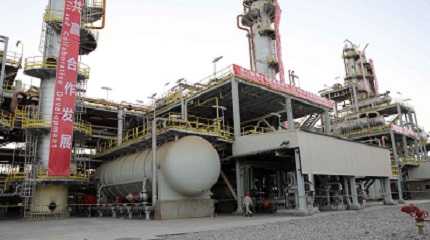
BAGHDAD, Oct. 5 (Xinhua) -- Chinese energy companies have completed the mechanical work for the first associated gas processing plant in the Halfaya oil field, which is located in Iraq's southern province of Maysan.
The plant, expected to be operational in the first half of next year, is part of Iraq's efforts to improve its capacity for processing gas, benefit economically from gas, and reduce carbon emissions.
Governor of Maysan Province Ali Douai said exploiting associated gas is one of the Iraqi government's priorities, noting that with the operation of the plant, five flaring sites will be shut down, contributing to reducing pollution.
At the ceremony to mark the completion of the mechanical work for the project, Ali Maarij, undersecretary of the Iraqi Oil Ministry for distribution affairs, also confirmed that the project is "one of the main projects in Iraq to eliminate gas flaring, treat it, and benefit from it."
While referring to Chinese companies' contribution to the project, the official said "the Chinese companies have made a distinguished presence in Iraq at more than one level," adding that "this will positively impact diplomatic and political relations between the two countries."
PetroChina and the China Petroleum Engineering and Construction Corporation (CPECC) have engaged in this project to help reduce the wasteful burning of gas in Iraq and bolster its green development.
Fang Jiazhong, head of PetroChina's Halfaya oil field, told Xinhua that the plant is the first of its kind ever built in Iraqi oil fields to take full advantage of the gas produced during oil extraction.
As the operator of the Halfaya oil field, PetroChina has invested more than one billion U.S. dollars in building the plant since 2019, which will convert associated gas into usable purified gas, liquefied petroleum gas, sulfur, etc., according to Fang.
The Halfaya oil field, covering an area of 288 square km, comprises more than 300 oil wells, three crude oil processing facilities, two power plants, a water treatment plant, a natural gas processing plant, and a civil airport.
As the oil field's annual production capacity is estimated at 20 million tonnes, the gas processing plant is expected to produce purified gas sufficient to generate 5 billion kilowatt-hours of electricity annually.
"Upon the completion of the plant, the energy shortage in Iraq will be significantly eased, with the environment and climate improved, more oil and gas products produced, and outstanding economic value created," Fang said, hailing the project as a model of Chinese-Iraqi cooperation within the framework of the Belt and Road Initiative.
CPECC, co-builder of the project, is responsible for the design, marketing, construction, trial operation, and maintenance of the plant, according to Jiang Feng, general manager of the CPECC's Middle East branch and head of the plant project.
"Most advanced technology and equipment have been applied in the project construction," Jiang said, noting that the project also provided numerous job opportunities for local people and will generate more social and economic value in the future.
Nashaat Dhiyaa, 31, an Iraqi engineer who worked with CPECC for more than six years, believed the gas processing plant would bring economic benefit to Iraq, whose power plants mainly operate on gas but are still reliant on gas imports from neighboring countries.
Talking about his achievements in CPECC, Dhiyaa said he has gained good experience and got promoted, as well as seen his financial situation greatly improved.
According to the World Bank report, Iraq's volume of flared gas exceeded 17 billion cubic meters in 2022, the world's second-most after Russia.




